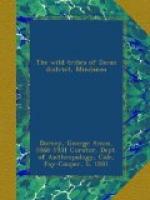[1] BLUMENTRITT, Smithsonian Report for 1899.
III. KULAMAN.
SYNONYMS.
(a) CULAMANES.
(b) MANOBO.
According to Governor Bolton this tribe numbers about thirty-five hundred individuals and occupies a considerable portion of the coast, and adjacent mountains, from the Padada river on the north to Sarangani Bay on the south. On the east side of Davao Gulf its members are found along the beach and in the mountains, from Sigaboy to Cape San Agustin, and also in a few scattered villages on the southeastern Pacific Coast.
By their neighbors they are known as Kulaman or Manobo. The former designation is translated as “bad man,” but it is probable that they received the name from the town of Kulaman, where they formerly resided. They are equally well known as Manobo—a word meaning “man.” Earlier writers, misled by these two names, have generally treated this people as forming two distinct groups, but this is quite incorrect, both names being applied to a part or to the whole of the tribe. It has also been customary to describe them as a part of the great Manobo tribe which inhabits a large portion of Central and Northeastern Mindanao. The writer is of the opinion that there is not sufficient evidence to justify such a classification and that for the present we must consider them as distinct from the Manobo of the northern district as are the other tribes of Davao Gulf.
According to their own tales, the Kulaman once held all the coast from the Padada River to Sarangani Bay, but did not extend far back from the sea, since in the mountains lived the Tagakaolo and Bila-an with whom they were constantly at war. When the Moro appeared on their coasts and offered help against the hill tribes in return for land, they were gladly received and were given several village sites near to the mouths of various rivers. Aside from a few minor quarrels, the Kulaman have always lived on friendly terms with these later comers, and not a few of the tribe have been converted to Mohammedism.
Influenced by their new allies they organized under several petty rulers who were subservient to the datu at Kulaman, and with this superior organization they were able to carry on such successful warfare against the hill tribes that the Tagakaolo were, for a time, partially under their rule.
When the Spaniards arrived and undertook to subdue the Moro, the Kulaman cast their lot with their Mohammedan allies, and even after the power of the Moro was broken, they remained irreconcilable and frequently raided the settlements under the care of the Spanish priests.




